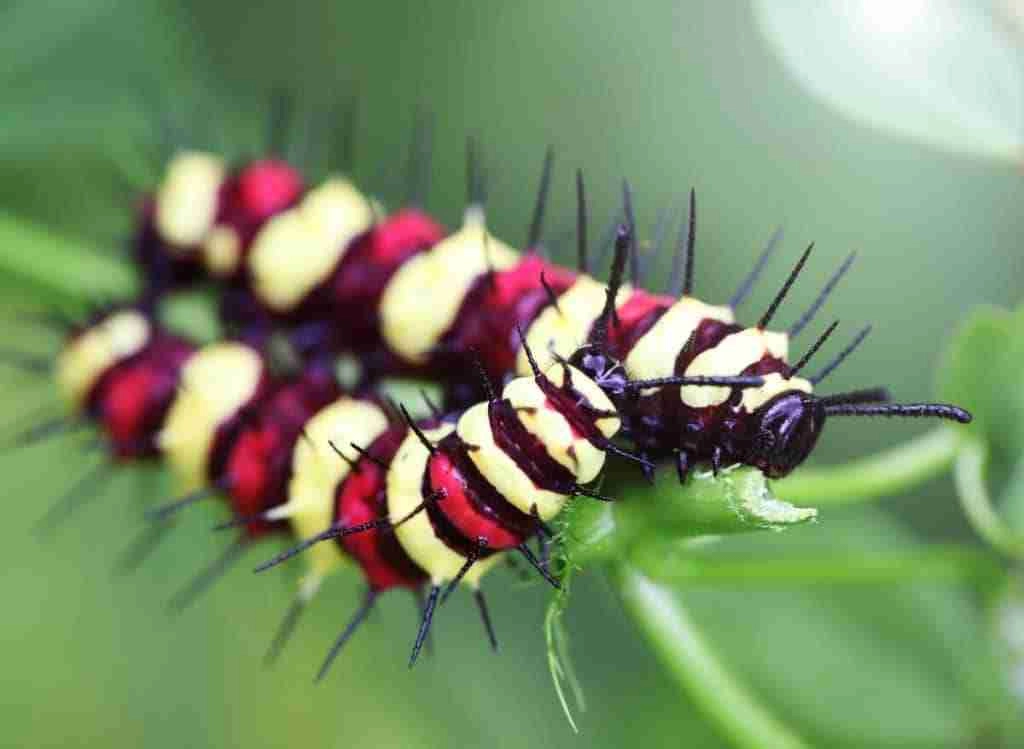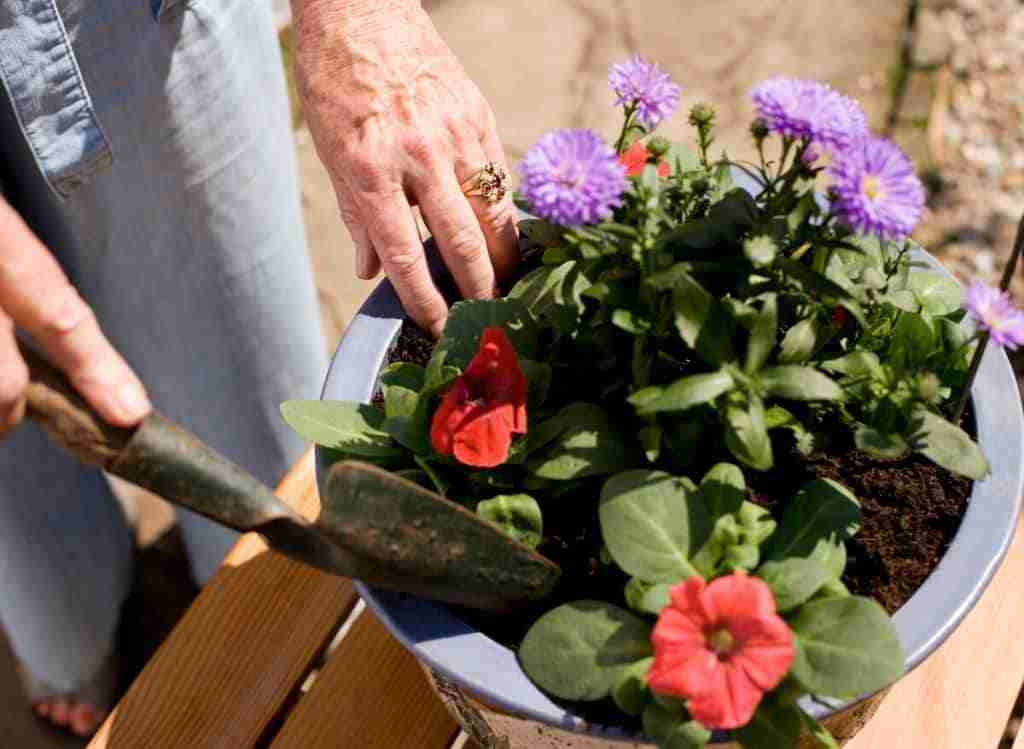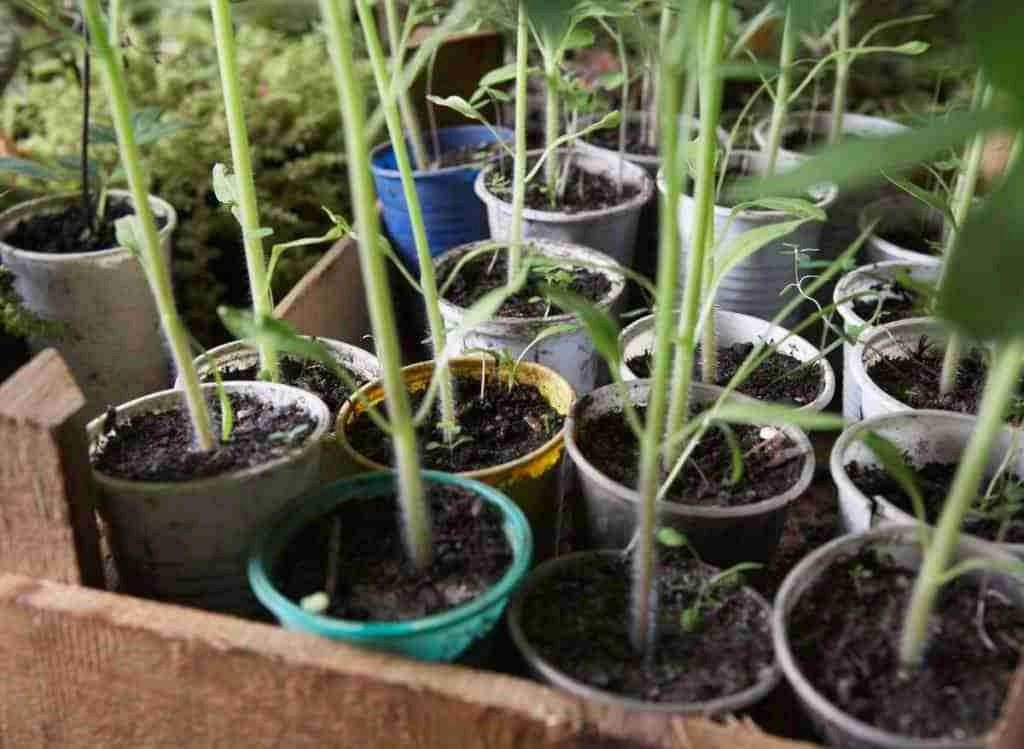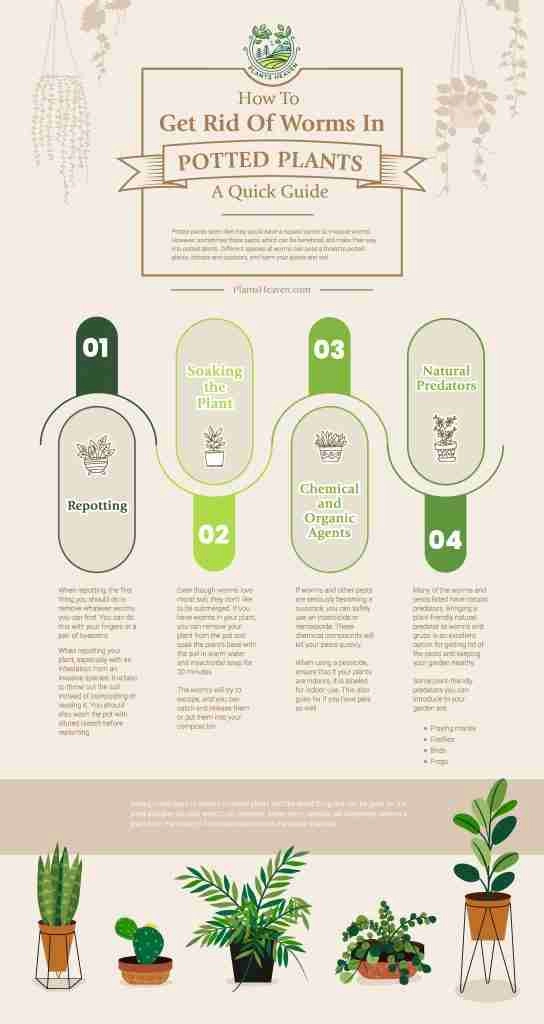This post contains affiliate links.

Potted plants seem like they would have a natural barrier to invasive worms. However, sometimes these pests, which can be beneficial, still make their way into potted plants. Different species of worms can pose a threat to potted plants, indoors and outdoors, and harm your plants and soil.
While many people choose to add a couple of worms to their potted plants for overall plant health, forgetting about them and allowing them to reproduce too much can cause problems.
Going through this guide will help you diagnose why you have worms and how to get rid of them in potted plants so your plants and soil can be happy and healthy.
Also see: How To Water Succulents Without Drainage: A Complete Guide
Why and How Worms Get Into Potted Plants?
Worms naturally occur in our soil and are remarkable for soil and plant health. They eat the dead plant matter and their excretions, also known as casings, are a natural, potent fertilizer for plants. They also aerate the soil to prevent it from being too compact.
The first step to getting rid of worms in your potted plants is to diagnose why there are worms. If you use potting soil, worms won’t be inside the bag, which is the only way to ensure sterile soil. If outdoors, worms will find their way into potted plants one way or another. Some of the reasons worms make their way into potted plants are:
- People place worms in them to help keep the soil healthy, then the worms reproduce.
- Bringing plants indoors from being outside where worms have found their way into it
- The plants are near other infested plants.
- Using soil from your yard that could potentially be infested
If you find worms, you should also make sure that they are a safe species to keep in a potted plant and don’t need to be exterminated. Worms also tend to prefer moist soil, so they will more likely be found in plants that need constant watering, unlike succulents.
Also see: How Long Does It Take Sevin Dust To Work? This Long!
How Worms Negatively Affect Potted Plants?
Worms can be pesky creatures when they are in your plants and not in your compost. Some ways that worms can positively and negatively affect your potted plants are:
- Eating decayed plant matter, and if there isn’t enough plant matter, they will start to eat the plant structures, especially the roots. This mostly occurs when too many worms are in a pot, and they have to compete for food.
- Some species are invasive and rely more on the plant itself than the soil, such as grub worms.
- Mature grubs (beetles) can eat plant leaves.
Having worms destroy a plant’s root system is almost irreversible because plants need strong, healthy roots to absorb nutrients.
Species of Worms in Potted Plants
Worms can come in all sizes and species and can do different things to and for plants. When people and animals get tapeworms, it’s not the same worm that will be in your garden.
Some worms that can be in your potted plants are:
- Earthworms
- Pot worms
- Redworms, also known as red wigglers
- Grub worms
- Nematodes
Out of the above species, not all of them are bad. Some of them can live in a pot in harmony with your plant until they overproduce. The ones you will want to get rid of ASAP are:
- Grubworms are the larvae of beetles. They have fat, white bodies that are curled up with legs towards the head. They will eat the roots of your plants within a matter of days. They focus on the roots until they are matured and then move to the plant stalk and leaves.
- Nematodes are mostly harmless; however, different species can harm plants, humans, and animals. The nematodes that harm plants will attack and eat the entire root system of a plant. Nematodes don’t naturally find their way to potted plants, but they sometimes can, primarily if you use soil or have introduced an outdoor plant to a pot.
Signs of a Worm Infestation in Potted Plants
While worms can be beneficial for many reasons, sometimes they can cause harm to potted plants. Some ways to know that you have an infestation are:
- There are holes at the top of the soil.
- You see worms at the surface.
- Your plant is starting to die because the roots are being destroyed.
- You can see excessive casings around drainage holes.
If you notice any of these signs, lift your plant out of its pot to see if there are any worms towards the plant’s bottom.
You may not see worms on the soil outside, so break it apart to see if you have worms. If you see worms, you’ll want to eliminate them.

Methods of Getting Rid of Worms in Potted Plants
Once you know what type of worms are in your potted plants and why they’re there, you can start preparing to get rid of them. Some methods to get rid of worms in potted plants are:
- Repot your plant and physically remove the worms
- Soaking the plant to chase out the worms
- Using a chemical or organic agent
- Introducing natural predators
1- Repotting
When you have worms, you might not notice them until you repot them anyway. They will hang out toward the pot’s bottom, especially earthworms. Red wigglers will be more toward the top of the plant, but when you repot your plant to give it fresh soil, you will see some wiggling friends.
When repotting, the first thing you should do is remove whatever worms you can find. You can do this with your fingers or a pair of tweezers.
Before repotting your plants with fresh potting mix and compost or fertilizer, rinse the roots to ensure no worms or eggs are stuck to the roots or the plant’s base. If you don’t rinse the roots, then you’ll risk any potential eggs left behind, hatching, and having worms in your plant.
When repotting your plant, especially with an infestation from an invasive species, it is best to throw out the soil instead of composting or reusing it. You should also wash the pot with diluted bleach before replanting.
2- Soaking The Plant
Even though worms love moist soil, they don’t like to be submerged. If you have worms in your plant, you can remove your plant from the pot and soak the plant’s base with the soil in warm water and insecticidal soap for 20 minutes. The worms will try to escape, and you can catch and release them or put them into your compost bin.
This works best for harmful worms. You shouldn’t do this with helpful worms because you can take them outside into the soil. Doing this with harmful worms will kill the worms and their larvae.
Using cool water is an easy way to remove the beneficial earthworms and red wigglers from a plant by soaking it. It won’t hurt the worms; it will just cause them to flee. You can add them to a compost bin or put them in your yard when they come out.
3- Chemical and Organic Agents
If worms and other pests are seriously becoming a nuisance, you can safely use an insecticide or nematocide. These chemical compounds will kill your pests quickly.
When using a pesticide, ensure that it is labeled for indoor use if your plants are indoors. This also goes for if you have pets as well. Certain pesticides are also recommended for specific plants. Also, confirm that the pesticide is okay on non-ornamental plants if you intend to use it on them.
One excellent pesticide is neem oil. Neem oil is a natural product from the neem tree, native to India. It not only works as a pesticide but also as a fungicide. It kills worms and pests in a number of ways, including disrupting their hormones. It is safe to use on vegetables and won’t kill earthworms. Neem oil is extremely effective against grubworms and hornworms.
Hot pepper wax is also an effective pesticide against many pests and worms. It also deters some more considerable garden nuisances, such as rabbits and deer, if your potted plants are outside. You can apply it every few days until the infestation is under control and then every few weeks for maintenance.
Also see: Is Sulfur Good For The Garden? Pros & Cons Of Using It
4- Natural Predators
Many of the worms and pests listed have natural predators. Bringing a plant-friendly natural predator to worms and grubs is an excellent option for getting rid of pests and keeping your garden healthy. Some plant-friendly predators you can introduce to your garden are:
- Praying mantis: are attracted to roses and berries. Keep tall grass around for a place for them to stay.
- Fireflies: keep shrubs around your yard, and fireflies will indeed show themselves at night.
- Birds: keep a birdhouse and feeder with fresh water readily available for them. They are more likely to come to your garden if you have a variety of plants.
- Frogs: if you live in an area where frogs are common, leave out some shelter and water for them. The buffet of bugs will definitely keep them there.
If you are bringing natural predators into your garden, make sure not to use any chemicals that could harm them. Also, keep an eye out for them when you are cutting your lawn and doing routine gardening; you wouldn’t want to kill them.
Preventing Worms and Other Pests from Returning:
After all the work you’ve done to get rid of the worms, the last thing you want is to have the worms come back. There are several things you can do to prevent worms from being in your potted plants, such as:
- Soaking the plant soil in warm, soapy water for 20 minutes before bringing it indoors.
- Turning and repotting plants in the spring will prevent eggs from hatching.
- Only use a potted plant mix or bake the soil at 180ºF for 30 minutes to kill any eggs.
- Don’t bring indoor plants outdoors.
- Keep any infested plants away from non-infested plants.
- Use pots with drainage holes to prevent soil from getting soggy.
- Clean your garden tools between working with plants so you don’t accidentally transfer insects from one plant to another.
- Always inspect any new plants you bring home for worms and other pests. After inspection, they should be isolated from other plants for at least two weeks.
- Create a barrier around the plant’s base with some cardboard. This works very well for cutworms.
- Make sure your plants are healthy. Healthy plants have more robust immune systems and are less attractive to pests.
Planting Natural Pesticides
Another excellent way to prevent worms and other pests from infecting your potted plants is to add to your collection! Individual plants are known as a deterrent to insects and attract some predators to pests.
If you are going to do this, be mindful of what plants you are planting because some plants may attract other pests.
| Plant | Pests They Repel | Pests They Attract |
| Cilantro | Caterpillars, aphids, spider mites | Aphids |
| Garlic | Root maggots, snails, slugs | Nematodes, leaf miners |
| Tansies | Cutworms, fleas, beetles, flies | Tansy aphid |
| Petunias | Aphids, leafhoppers | Caterpillars, mites |
| Mint | Aphids, ants, beetles, whiteflies, moths | Spider mites |
| Chrysanthemums | Ants, silverfish, roaches, lice, bedbugs | Caterpillars, thrips, beetles |
Other organic methods to get rid of and prevent pests from being in your potted plant are to:
- Add used coffee grounds to the top of the soil. This will also help blue flowers like hydrangeas appear bluer.
- Sprinkle some diatomaceous earth around your plant bases.

Keeping Worms in Your Potted Plants
Even though worms can be invasive if they overpopulate, they can be significant for a plant’s overall health. If you have earthworms or red wigglers but don’t want to get rid of all of them, you can keep a few of them in your pots. If you are going to keep your worms, make sure to:
- Keep the plants watered but not soggy. Worms don’t like dry soil.
- Keep the soil slightly acidic. Worms do well in soil that has a pH over 6.
- Make sure your plants don’t get too hot or cold—worms like moderate temperatures.
- Don’t remove dead leaves from your pot unless you suspect the plant is sick.
- Avoid using inorganic fertilizers because they could kill the worm population. Stick with neem oil.
- Check your worm population every 2-3 months because that’s when hatched eggs become sexually mature.
Other Parasites That Can Affect Your Potted Plants and How to Get Rid of Them
Worms aren’t the only creatures who will find their way toward your plants and soil. Certain species and locations will attract different bugs and parasites to your plant, and while it is necessary for their life, it is a problem for you. Some other bugs that can affect your plants are:
- Millipedes
- Cutworms and caterpillars
- Aphids
- Weevils
- Whiteflies
1- Millipedes
Millipedes look like and act like worms. They come in many sizes and colors. Most species are vegetarians; however, the larger species will eat other insects.
They won’t pose too much of a threat to your potted plants, but if your potted plants are indoors, you will want to remove these pests as soon as you notice them.
Millipedes in your potted plants won’t be a problem unless your plant is starting to die from sickness, lack of care and nutrition, or an infestation. When removing millipedes, you should wear protective gloves and goggles because some species will emit a fluid known to irritate the eyes and skin.
You generally don’t have to remove millipedes from plants, but if they become a nuisance and eat your plant, you should clean the drip tray, remove the millipedes, and spray an insecticide on the top of the soil. If there are too many or you can’t seem to get rid of them, and they’ve invaded your home, you can call a professional in to help.
Another way to deal with millipedes, mostly if they’ve made their way into your home, is to place millipede traps around your house, especially in damp and dark places. You should also use a dehumidifier in your home to make them less likely to leave the plants.
2- Cutworms and Caterpillars
Cutworms are moth larvae and can be detrimental to potted plants and gardens. You won’t find them in the soil like most of the pests mentioned. They will be found on plant stems and leaves. If they molt and reproduce, they can kill an entire garden because all caterpillars do eat plants. Eric Carle wasn’t lying about “The Very Hungry Caterpillar.”
Cutworms particularly enjoy vegetable plants, especially carrot and tomato plants. They come in black, pink, white, and green, with various patterns like spots and stripes. You’re bound to find more when you notice one cutworm because they reproduce in large numbers.
The best way to get rid of cutworms and caterpillars is to make a dish soap and water solution and spray the plants. Cutworms are most active at night, so you can spray them then. You may need to do this a few times to ensure they die. You can also pick them off of your plants and place them in hot, soapy water to kill them.
If the cutworms don’t die, you can always purchase a pesticide, such as pyrethrin, to spray on your plants, suited for cutworms and caterpillars.
3- Aphids
Aphids tend to stay on the underside of leaves. You should regularly inspect under leaves for them. Not only do aphids enjoy eating plants, but they also have a secretion that leaves a residue on the plant leaves. This residue prevents the plant from getting the right amount of sunlight, preventing photosynthesis.
A great way to remove aphids from your plant is to spray a mixture of insecticidal soap and water on them until the insects and eggs are gone.
You can also use a plant-safe cloth dampened with warm, soapy water to wipe down the leaves of plants with larger leaves. This even will kill and prevent spider mites and whiteflies.
4- Weevils
Weevils are awful pests that will eat many different plants and will eat the whole plant. They are a pest that should be gotten rid of immediately, or else the infestation could quickly take over and ruin your plants and garden. While not particularly common in potted plants, a weevil infestation could be detrimental.
An excellent way to get rid of weevils is to shake them free from the plants and place sticky traps around them. The scent of the sticky trap will attract them.
You should also sprinkle fertilizer on top of the soil every three months and a pesticide to keep them away.
5- Whiteflies
Whiteflies are tiny insects that will be found on the underside of plant leaves. Lightly tapping the top of the leaf could send dozens flying all over. They are found in large numbers and can contribute to yellowing in plant leaves. Like aphids, whiteflies produce a secretion that inhibits photosynthesis.
You can spray your plant leaves with water to get rid of whiteflies. It’s best to do this in the morning, reducing the chances of mold growing on the leaves.
If mold grows on the leaves, it could potentially attract other pests while killing the plant. Another way to get rid of whiteflies is to use neem oil.

Indoor and Outdoor Potted Plants
Whether your potted plants are indoors or outdoors, they can be exposed to different parasites or are more likely to attract different ones. As mentioned earlier, even though your plant is potted and less likely to have worms in them, it isn’t inevitable, even if they’re indoors.
If you don’t have a healthy amount of worms in your potted plant or don’t want them, you can remove them.
Outdoor plants will be more likely to have pests attracted to them than indoor plants, but it is almost impossible to prevent all pests from coming indoors since windows and doors can be left open, and many of these pests can fly through screens.
Worms in the Ground
Worms will almost always appear in the ground of your garden, and they aren’t always the worst thing for your garden. In fact, having worms will give you a healthier garden. In the ground, worms provide many benefits, including:
- Eating decayed plant matter creates natural, rich fertilizer.
- Burrowing through the soil to allow better airflow
How to Know When There are Too Many Worms?
Even though worms in the ground can benefit your garden, they can sometimes overproduce and harm your garden. Too many worms in your garden can cause the soil to have excess nutrients and burn your soil and plants.
If you notice your garden plants are starting to yellow, have slow or no growth, or can even see the fertilizer on top of the soil, there is a chance there are too many worms in your yard.
If there are too many worms in your yard, you can safely draw them out of the ground with an electric worm probe. You can relocate them to another part of your yard that isn’t affected or use them as bait. Afterward, rake your garden soil to break up any leftover eggs and distribute the fertilizer.
Useful Worms
With the many species of worms out there that can occur in gardens, some worms can be useful for some of the reasons mentioned above and more! The main reason worms benefit soil is that their waste will benefit the soil. Here are some great worms that can be friends with your garden and compost:
- Earthworms are great in your garden. They will burrow through the soil and promote aeration, especially in compact soil.
- Red wigglers are known as composting worms and will go great in a compost pile to help speed up the process and guarantee nutritious compost for your plants. Using these to help aid composting is known as vermicomposting. They are about 2-3 inches long and are red and yellow.
- Pot worms are small, white worms. They will eat decaying plant matter and aerate your soil. If you do have them, you should monitor them because they can quickly overproduce, and if there isn’t enough decayed matter in your pot, they will eat your plants.
- Nematodes can be beneficial. Not all species of nematodes are harmful to plants. Some nematode species will not only eat dead plant matter, but they can also eat other invasive pests in your potted plants.
Vermicomposting
Vermicomposting is an excellent way to utilize worms. You can buy or create a particular compost bin with holes in it for aeration and add composting worms. Vermicomposting has many benefits, including a faster turnover time for the compost. The compost from vermicompost is a fantastic, natural, and nutritious fertilizer for plants.
When using a vermicompost bin, make sure that it isn’t too deep because red wigglers don’t like to burrow very deep. Here’s a great video outlining vermicomposting. Some excellent things you can add to your vermicompost are:
- Soil and eggshells to improve their digestion
- Shredded paper and cardboard for burrowing
- Fruit and vegetable scraps for food
- Dead leaves from plants and your yard for food
When using your compost, be sure to search through for the worms before placing them in your potted plants unless you want to add one to your pot.
Ensure there is still enough organic material for any worms left inside to compost, or else they will starve. You should also avoid adding.
Final Thoughts
Seeing some types of worms in potted plants isn’t the worst thing and can be great for the plant and give you less work to do.
However, some worm species will completely destroy a plant from the roots up if not taken care of with the above methods.


